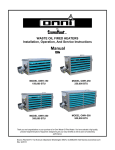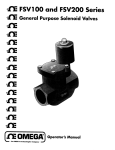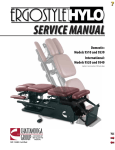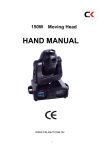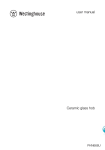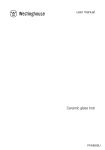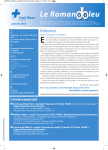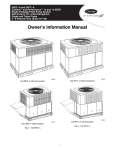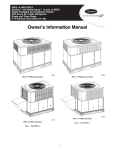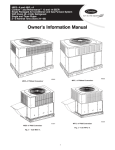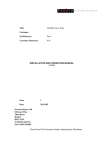Download Omega Engineering RG-2500 User's Manual
Transcript
&E RG-2500 Series a Tipping Bucket Rain Gauge 03-I 8 Operator% ManMal Servicing USA and Canada: Call OMEGA Toll Free Canada USA One OmegaDrive, Box 4047 Stamford, CT 06907-0047 Telephone: (203) 359-1660 FAX: (203) 359-7700 976 Bergar Lava1 (Quebec)H7L5Al Telephone: (514) 856-6928 FAX: (514) 856-6886 Sales Service: l-800-826-6342/ l-BOO-TC-OMEGASM Customer Service: l-800-622-2378/ l-BOO-622-BESTSM Engineering Service: l-800-872-9436/ l-BOO-USA-WHENSM TELEX: 996404 EASYLINK: 62968934 CABLE: OMEGA Servicing Europe: United Kingdom Sales and Distribution Center 25 Swannington Road, Broughton Astley, Leicestershire LE9 6TU, England Telephone: 44 (1455) 285520FAX: 44 (1455) 283912 The OMEGA Complete Measurement and iControl Handbboks & Encyclopedias v r/ V Data Acquisition Systems 1/ Electric Heaters r/ Environmental Monitoring and Control Temperature Pressure, Strain & Force P Flow and Level v pH and Conductivit y Call for Your FREE Handbook Request Form Today: (203) 3591RUSH I MSSO395FVRlB yI Y i Unpacking Instructions Remove the Packing List and verify that you have received all equipment, including the following (quantities in parentheses): RG-2500 Tipping Bucket Rain Gauge (1) Operator’s Manual (1) If you have any questions about the shipment, please call the OMEGA Customer Service Department. When you receive the shipment, inspect the container and equipment for signs of damage. Note any evidence of rough handling in transit. Immediately report any damage to the shipping agent. The carrier will not honor damage claims unless all shipping material is saved for inspection. After examining and removing contents, save packing material and carton in the event reshipment is necessary. Y TABLE OF CONTENTS 1. Chapter 1 Introduction ......................................... 1.1 General Description ................... ‘ ................. 1 .1 1.2 Specifications....................................... Chapter 2 Installation .......................................... 2 2.1 Site Requirements ..................................... 2 2.2 Installation.......................................... 2 Chapter 3 Operation . . . . . . . . . . . . . . , . . . . . . . . . . . . . . . . . . . , , . . . . . . .3 Chapter 4 Calibration.......................................... 4.1 Factory Calibration .................................... 4.2 Calibration Procedure................................... 4.3 Field Calibration ...................................... 4.4 Adjustments ......................................... Chapter 5 Maintenance Chapter 6 Troubleshooting . . . . . . . . . . . . . . . . . . . . . . . . . . . . . . . . . . . . . . . . .6 . . . . . . . . . . . . . . . . . . . . . . . . , . . . . , . . . . . . . . .6 3 3 3 4 4 . Chapter 1: Introduction 1.1 General Description The RG-2500 Series consists of two high quality rain gauges, Models RG-2500RGand 2500-12. Model RG-2500 features a standard eight-inch diameter orifice, while the Model RG-2500-12 has a twelve-inch diameter orifice. Both gauges have been designed with high grade materials and have been built to provide years of trouble-free operation. Each of the two gauges consists of a main collection funnel, an outer cover, an internal funnel, a tipping bucket and magnetic switch assembly, a base, and mounting feet with leveling adjustments. Electrically heated versions of both gauges can be provided for use in cold climates, for measuring frozen precipitation such as snow and sleet. The electrically heated versions include the features listed above plus a heater element, a thermostat, a fuse holder and fuse, and associated wiring and terminal blocks. The model numbers for the heated rain gauges are RG-2500E andRG-2500E-12. 1.2 Specifications Capacity: Unlimited Orifice: RG-2500: 8” (20 cm) RG-2500-12: 12” (30 cm) Calibration: 0.01” per tip (0.25 mm), others on request Accuracy: + 1% for 1 to 3 inches per hour, + 3% for 0 to 6 inches per hour Switch: Magnetic reed, SPST N.O., 10 Watts, 200 Vdc, 0.5 A max Dimensions: RG-2500: 8” x 17 ” RG-2500-12: 12” x 20 ” Weight/Shipping: RG-2500: 7lbs/12 lbs RG-2500-12: 14lbs/18 lbs Optional Accessories: Wind Screen, Alter Type Event Recorder, Drum Chart Calibrator Bottle Digital Event Counter Model RG-952 Model RG-6113-A Model RG-2595 Model RG-2596 1 Chapter 2: Installation 2.1 Site Requirements The location of the rain gauge is very important to the successful operation of the instrument. The most accurate measurements are made in relatively sheltered areas protected from gusting and turbulent winds. Openings in orchards or a grove of trees offer the best exposure for the rain gauge. Fences and other structures can help serve as a wind break as long as they are not too tall. In areas that are open with no nearby structures, a wind screen such is recommended to protect against wind effects. Generally, the heights of objects near a rain gauge should be proportional to the distance away from the gauge. The distance of a nearby object should always be at least twice the height of the object above the gauge. Wind effects on catch losses are more pronounced during snow storms than during a rain storm. A wind screen is generally not used at locations where snowfall constitutes less than 20% of the mean annual precipitation. Good locations do not always remain free of obstructions. Vegetation can grow quickly, changing an excellent exposure into a poor one. Sites should be inspected regularly in order to properly maintain the exposure of the gauge. In locations with heavy snowfall, the gauge should be mounted on a support or tower to place the gaugewell above the average local snow level. The exposure would be best if the tower wereto be located among trees of the same height as the tower. 2.2 Installation OMEGA@ rain gauges are shipped as a complete assembly with no additional assembly required. ‘The gauge, however, should be installed onto a platform or foundation that fairly is close to being level to minimize the amount of adjustment required after the gauge is mounted. Each gauge is equipped with three mounting brackets that also serve as feet. Each 3/8 inches. The holes in the feet should be foot has a mounting hole with a diameter of matched to anchor bolts located in the foundation or on the platforms. for severely tilted foundations, use a set of three hex nuts on each bolt to provide leveling and locking of the rain gauge onto the foundation. For slightly tilted foundations, use the adjustable leveling knobs above each foot to level the gauge. An internally mounted spirit level may be used to assist in the leveling process. A rough level can be taken by placing a carpenter ’s level across the top of the gauge funnel. Flat washers may be used as shims to help correct large leveling differences. Place the shims under the mounting feet. A lock washer and a hex nut should be used to secure the gauge onto the anchor bolts. Some correction of the level may be necessary after tightening the hex nuts. 2 The leveling knobs located above the mounting feet are secured using allen head set screws. These set screws must be loosened before the knobs can be moved. The set screws are accessible from the sides of the base. Re-tighten the set screws after leveling the gauge to help ensure that the level adjustment will not shift due to loose screws. The gauge may be installed with the outer cover on or with it removed. Three screws hold the outer cover in place. Take out these three screws to remove the cover. Carefully remove the cover, avoiding hitting any of the internal rain gauge parts. Some of the moving parts are tied down to prevent movement and possible damage during shipping. Remove any tape, plastic ties, foam inserts, or other objects used to keep the tipping buckets from moving. The bucket assembly should move easily with the packing materials removed. Chapter 3: Operation The rain gauge operation is relatively simple. As rain is collected by the eight-inch diameter orifice, the rain drops are directed down through the funnel and into the bucket assembly. As soon as the bucket has collected enough rain to represent 0.01 inches (or 0.25 mm) of rain, the bucket tips. The rain drains out through the drain collection tubes and the magnet is moved past the reed switch. The reed switch closes momentarily, making an electrical contact that is used in conjunction with electronic counting and recording instruments. Chapter 4: Calibration 4.1 Factory Calibration Each rain gauge is thoroughly tested before being shipped to the customer. A measured amount of water is passed through the rain gauge to give an expected number of counts according to the diameter of the orifice. The bucket calibration posts have screws that are adjusted until the correct number of counts are achieved with repeated testing. The exact number of counts or nearly the exact number are recorded for each gauge. As long as the number of counts is within the specified accuracy of the gauge, the calibration will be accepted. The calibration of the gauge should not change during shipping unless the gauge becomes damaged. Checking of the gauge calibration may be made after the gauge has been installed to ensure the accuracy of the data. 4.2 Calibration Procedure The rain gauge calibration may be checked using a graduated burette or cylinder. Wet the gauge thoroughly allowing water to flow through the gauge before beginning the test. The the gauge wetting of the gauge helps compensate for water that may adhereportions.of to causing some error in the counts. 3 Allow a measured amount of water to flow into the gauge at a specified rate. Refer to the table shown below. The tipping bucket should begin tipping and will give the number of tips calculated. The tips may be counted by listening to the bucket assembly and manually tabulating the count or by using the electronic monitoring equipment that is to be connected to the rain gauge during its normal operation. Should the gauge appear to need adjustment, make the adjustments in small increments and retest each change at least three times. Standard Rain Gauge Calibration Table Tip Volume of Water RG-2500 0.01” 8.24 ml RG-2500 0.05” 41.20 ml RG-2500 0.2 m m 6.48 ml RG-2500 0.5 mm 16.215 ml RG-2500-12 0.01” 18.53 ml RG-2500-12 0.2 mm 14.60 ml RG-2500-12 0.5 mm 36.48 ml Model Number Use a flow rate of 1 ml per second to avoid over filling of the buckets and loss of water due to splashing. the desired accuracy is~3% of the volume at 1 to 6 inches of precipitation per hour. Best results are obtained by taking a multiple of the volume of water and counting a number of tips. For example, the 0.01 ” calibration at 100 counts requires 824 milliliters of water. 4.3 Field Calibration To verify the rain gauge calibration after the gauge has been installed, best results may be obtained using the calibration bottle. The bottle may be filled to the specified level and then placed into the funnel of the gauge. While the bottle slowly empties the water into the funnel other tasks may be performed if necessary. If the calibration bottle is not available, use any calibrated measuring device and slowly pour the water into the gauge. Keep track of the bucket tips either manually or through the use of the electronic monitoring equipment. For 45% since the control of the methods is field testing methods, use an expected accuracy of not as good as when the testing is done in the laboratory. The total number of tips should equal the amount of water poured into the gauge, divided by the calibrated number of tips per the number of milliliters of water shown in the table. For example, a quart of water is fof a quart of equal to 946.3 milliliters. So for a 0.01 ” calibration, the number of counts water should be 946.3 t 8.24 = 114.8. 4.4 Adjustments Should the calibration of the rain gauge appear to be incorrect and in need of adjustment, change the heights of the two calibration posts adjustment screws. To change the screw heights, loosen the nut on the top of the post that locks the screw into place. Rotate each screw by a small amount only and recheck the calibration for the new screw positions. Empty all water from the buckets but do not dry off the buckets. The exact amount of water needed for a single bucket tip may be added into a bucket to see how closely the calibration post screw may be to the position needed for the bucket to tip. After obtaining this point of adjustment, tighten down the locking nuts on the calibration posts screws and test the gauge using a large amount of water at the proper flow rate and count the total number of tips. The calibration post screws should be adjusted upward whenever the amount of water needed to cause the bucket to tip is more than the amount shown in the calibration table. Whenever less water than the amount in the table causes the bucket to tip, the screws need to be adjusted downward. The two sides of the bucket assembly should generally be at about the same calibration adjustment. There may be situations where one of the bucket calibration post screws has moved and is off more than the other screw. In this situation the single tip amount of water calibration method may be better for correcting the one side of the bucket to match the other side more closely. Do not dry the buckets during the adjustment procedure. Carefully tighten the locking nuts on the calibration post screws after completing the adjustments. Recheck the calibration to ensure that the screws have not shifted as the nuts were tightened. Chapter 5: Maintenance Annual maintenance of the rain gauge is recommended. Cleaning of the gauge more often may be necessary in areas where there is a lot of leaves, dust, and other debris that falls into the gauge. Cleaning includes removal of the outer cover, rinsing and drying off of the buckets, cleaning of the drain holes, and removal of debris from all of the screens. the outer and inner funnels should also be rinsed and dried off to remove dirt, dust and insects. The gauge calibration should be tested during the maintenance procedure and adjusted if necessary. If there is a regularly scheduled maintenance of the gauge on a monthly basis, the calibration can be tested less often. At least once a year, or if possible, after six months of heavy operation, a drop of light machine oil should be placed onto the bearings. Do not over-oil and wipe off any excess oil. The electrical output of the gauge should be tested to ensure that the magnet and switch assemblies are still functioning. The switch used in the gauge is a momentary contact, normally open, single pole switch. Test the switch using an ohmmeter, buzzer, or counter, or 5 by observing the data of the monitoring equipmen normally connected to the rain gauge. Manually move the bucket assembly and look for he switch closure. ge, replace the outer cover and funnel and Upon completion of testing and cleaning of the1ga recheck the level of the gauge using a carpenter ’s level across the top of the gauge. Adjust the leveling knobs at the mounting feet if the level is out of adjustment. Replace or repair any of the gauge components that appear to be damaged or are not functioning properly. The outer funnel should be replaced if the rim has become dented or bent. Repaint the outer cover as needed. Replace any hardware that is missing or has become rusted and corroded. Inspect the signal and any power cables for signs of wear or damage that may expose the wires. Replace the cables as needed. Use wire ties to secure the cables to prevent damage from high winds. For best results, use conduit to protect the cables. Chapter 6: Troubleshooting Failure of the rain gauge to operate usually is the result of loose wiring. Inspect the cable connections to ensure the connections are solid and are correctly made. Inspect the motion of the bucket assembly to ensure that the buckets move smoothly and without any interference. Check the magnet to see that it passes over the switch without any physical contact and that the switch closes when the magnet passes over it. Should the bucket motion appear to be sticky, remove the bearings and inspect them for wear. Annual replacement of the bearings may be necessary in areas where there are high amounts of rain. Check the inlet funnel and funnel screens for blockage whenever the rain gauge operation appears to be low or missing. Also inspect the drain tubes for debris that may interfere with the bucket motion. Whenever the rain gauge output appears to be too high, check to ensure that the gauge is still level and recheck the calibration. 6 -- r Z-PI N TERMINAL BLOCK MAGNETIC SWITCH 25 FT CABLE MODEL 330-022 ( TYP IC A L) ( NORMALLY 0 DIODE __ _ __ OPEN) ------- -- 2-PI N TB RED &w DIODE * SWITCH BLK IL7 -0 BLK MAGNET N.O. 27 VD C MAXIMUM 3 WATT S 0.25A @ 175 VD MAXIMU M C TYPICAL CLOSURE TIME 0.1 SECON D NOTES: 1. TYPICAL OF BOTH HEATED AND UNHEATED RAIN GAUGES . w - t 25x CASE GROUND /ib 4-PI N TERMINAL BLOC K 10 FUSE 5 AM P SLO BLO 25 FT POWER CORD 18 AWG, SVT - 34 OHMS FIRE ROD HEATER 400 W @ 115 VA C WARN’.ING 115 VAC WILL BE ALIVE ON THE 4-PI N TERMINAL BLOCK WHENEVER THE POWE R CORD IS PLUGGED INTO A POWER OUTLET . T!iE RAI N TERMINALS ARE EXPOSED INSIDE GAUGE. 0347 ; o \, 8.0” ------I MOUNTING FEET PAT WTH LEVELER L(oo. \ BY 0.7t: 0. ..‘. -. .- 2C 5” MOUNTING FEET PAT + 2.0” t MOUNTING FOOT WlTH LEVELER uoo. u - \< By OAIE a a I= RAIN GAGE FUNNEL INNER FUNNEL 7 CALIBRATION POST SCREW & ADJUSTMENT 2 PIN SIGNAL f- TERMINAL BLOCK TIPPING BUCKET \ SIGNAL OUTPUT CONTACT CLOSURE COLLECTION TUBE FOOJI~JE MTH LEVELER 12 INCH RAIN GAGE BASE ASSEMBL I Y 1, OAIE ,/ THERMOS ‘TAT % RAIN GAGE FUNNE L\ d_ BOTTOM VIEW SIDE VIEW (WIRING OMITTED) W lT H LE VIEW OF MAGNET SIDE M LER RAIN GAGE BASE ASSEMBLY E NOTES - 1. 4 PIN TERMINAL BLOCK IS POSITIONED BEHIND HEATER 2. OUTER COVER NOT SHOWN. ’ nn . 1 UOD. U REVISED AUG 1994 tL MOUNTING BOLT ASSEMBLY DETAIL PART NUMBEfiS RAI 72270101 72341501 7231750 2 5/16 HEX NUT 5/16 LOCK WASHER 5/16 FLAT WASHER g 7231750 5/16 FLAT WASHER v 2 72270101 5/16 HEX NUT 72270101 5/16 HEX NUT & LOC HEIG LOC 7250000 0 5/16 THREADED ROD 7231760 2 3/8 FLAT WASHER & ANC 5/16 HEX NUT & A 72270101 I FOR INSTALLATIONS USING A 24” ALTER ST WIND SCREEN THIS HEIGHT MUST BE ADJUSTED SO THAT THE TOP EDGE OF THE RAIN GAGE IS WITHIN 1 INCH OF THE TOP EDGE OF THE WIND SCREEN LEAVES. SET BOLT HEIGHT PRIOR TO POURING CONCRETE FOUNDATION. TYPICAL LENGTH OF THREADED ROD WILL BE APPROXIMATELY 24 INCHES. SET HEIGHT ADJUSTING NUTS FOR ALL THREE OF THE RAIN GAGE MOUNTING FEET UNTIL THE RAIN GAGE IS LEVEL ACCORDING TO THE SPIRI BUBBLE LEVEL LOCATED ON THE RAIN GAGE B FOR WOODEN PLATFORMS THERE ARE EXTRA NUTS AND WASHERS. I TYPICAL VIEW nRE K Yoo. By 1 DATE MOUNTING BOLT ASSEMBLY DETAIL PART NUMBERS c ~ 20.75” 12 INCH RAIN GAGE I 7227010 1 7234150 1 7231750 2 7231750 2 5/16 HEX NUT 5/16 LOCK WASHER 5j16 FLAT WASHER @ & 5/16 FLAT WASHER F 7227010 1 5/16 HEX NU T 7227010 1 5/16 HEX NUT &I RAIN LOC HEIG LOC 7250000 0 5/16 THREADED ROD 7231760 2 3/8 FLAT WASHER & ANC 5/16 HEX NUT & ANC 7227010 1 I TYPICAL OF THREE EAC ! 15.25” APPROX t GROUND LEVEL (APPROX) 12” APPROk I 7r II II II -# Ll CONCRETE FOUNDATION TYPICAL VIEW II FOR INSTALLATIONS USING A 36” ALTER STYLE WIND SCREEN THIS HEIGHT MUST BE ADJUSTED SO THAT THE TOP EDGE OF THE RAIN GAGE IS WITHIN 1 INCH OF THE TOP EDGE OF THE WIND SCREEN LEAVES. SET BOLT HEIGHT PRIOR TO POURING CONCRETE FOUNDATION. TYPICAL LENGTH OF THREADED ROD WILL BE APPROXIMATELY 30 INCHES. SET HEIGHT ADJUSTING ,NUTS FOR ALL TH OF THE RAIN GAGE MOUNTING FEET UNTIL THE RAIN GAGE IS LEVEL ACCORDING TO THE SPIR BUBBLE LEVEL LOCATED ON THE RAIN GAGE B ANCHOR NUT AND 3/8 WASHER. ’ "RE R K UOD. U BY \ , DATE I /-- \\ I\\ I’,\ \ I I 1’1 S I LVER TAPE THERMOSTAT BRACKET (SHOWN IN INVERTED 00 :: INSULATING FOIL 25 - x11" i POUTION) 42 i \ 1 2 - x11” C FIREROD HEATE R THERMOSTAT HEAT S I NK TUBE CLAMP PLUG -+ SOCKET W ARN I NG LABEL DRAWING NOT TO SCALE \ PARTS LIST TIPPING BUCKET RAIN GAUGE MODEL RG-2500 8 INCH ORIFICE, 0.01 INCH PER TIP NL P/N DESCRIPTION 10000006 10000007 10000008 10000009 1000001 1 1000002 4 1000002 6 1000002 7 1000002 8 1000002 9 1000003 0 1000011 6 1000013 9 1000014 0 2105140 1 2500000 2 2800040 2 4080330 1 4190060 0 4631150 1 5100180 2 6480200 1 7101000 0 7113110 2 7208210 2 7208400 2 7212200 3 7214630 1 7214820 1 7218800 2 7218800 3 7221140 1 7222520 1 7224630 2 7230030 1 7231050 2 7234140 1 7245060 1 7245060 2 7245060 3 7260000 0 A10078 5 A10078 6 FUNNEL.INNER .................... SHAFT, BUCKET .................... ................... FOOT, LEVELING ................... KNOB, LEVELING BRACKET, BUCKET ................... BUCKET, 0.01" .................... .............. SCREEN, l-5/8 DRAIN TUBE OTY ............... HOLDER, MAGNET 3/8 DIA .................. COVER, MAGNET ARM .................. TUBE, COLLECTION ............... POST, CALIBRATION SCREW ................. FUNNEL, 8" ANODIZED ................ COVER, 8" RAIN GAUGE ................. 8" RAIN GAUGE BASE , ................ TERMINAL BLOCK, 2 PIN MAGNET, 3/8DIA ................... .............. .875 DIA BLACK PLUG, VENT .......... PLUG, HOLE S/8 DIA NYLON NATURAL ............ SPADE LUG #6 NYLON INSULATED ............... SURGE PROTECTION DIODE SWITCHp M RRQXIMITY, 12" LEAD S ......... .............. LEVEL, BUBBLE SPIRIT SS'MiNI ............. 0.25x0.375 BEARING, E-RING, 1/4IDX.210X.O29 S S SCRU, 6-32X3/8 BIND HD SLOT S'S ........................ .......... SCRU, 1/4-20X5/8 BIND HD SLOT SS ............. SCRU, 2-56X3/8 SOCKET HD SS ............... SCRU, 8-32X3/16 SET S S SCRU, l/4-20)31/4 SET S S ............... ........ SCRU, 10-32X1/2 BUTN HD SOCKT CAP SS .......... SCRU, 10-32X1/2 HEX WASHER HD SS ............. 4 NUT, 6-32 HEX SS 5/16X7/6 ..... . 8 NUT, 8-32 HEX SS 11/32X1/ NUT, ACORN 8-32 HEX SS .330X:37 5 13/64X7/16X:O;l' : .................... WASHER, FLAT NO. 10 SS ........ WASHER, FLAT l/4 TEFLON .25X.50X.062 ......... WASHER, SPLIT l/4 SS .255X.493X.062 STUD, 6-32X2SS.. ................. STUD, 8-32X2SS.. ................. ................ S STUD, 10-32X1-1/2 S WRENCH, ALLEN1/8 .................. SCREEN, 2" DIA, SMALL FUNNELL ............ ............. SCREEN, 7-S/8, LARGE FUNNEL 15 . . . . . . . . . . . . . . . . . . . . . . . . . . . . . . . . . . . . . . . . 1 1 3 3 1 1 2 1 1 2 2 1 1 1 1 1 3 1 6 1 1 1 2 2 2 2 3 5 3 2 3 2 2 2 5 2 2 1 2 3 1 1 1 Y 16 WARRANTY OMEGA warrants this unit to be free of defects in materials and workmanship and to give satisfactory service for a period of 13 months from date of purchase. OMEGA Warranty adds an additional one (1) month grace period to the normal one (1) year product warranty to cover handling and shipping time. This ensures that OMEGA ’s customers receive maximum coverage on each product. If the unit should malfunction, it must be returned to the factory for evaluation. OMEGA ’s Customer Service Department will issue an Authorized Return (AR) number immediately upon phone or written request. Upon examination by OMEGA, if the unit is found to be defective it will be repaired or replaced at no charge. However, this WARRANTY is VOID if the unit shows evidence of having been tampered with or shows evidence of being damaged as a result of excessive corrosion; or current, heat, moisture or vibration; improper specification; misapplication; misuse or other operating conditions outside of OMEGA ’s control. Components which wear or which are damaged by misuse are not warranted. These include contact points, fuses, andtriacs. OMEGA is glad to offer suggestions on the use of its various products. Nevertheless, OMEGA only warrants that the parts manufactured by it will be as specified and free of defects. OMEGA MAKES NO OTHER WARRANTIES OR REPRESENTATIONS OF ANY KIND WHATSOEVER, EXPRESSED OR IMPLIED, EXCEPT THAT OF TITLE AND ALL IMPLIED WARRANTIES INCLUDING ANY WARRANTY OF MERCHANTABILITY AND FITNESS FOR A PARTICULAR PURPOSE ARE HEREBY DISCLAIMED. LIMITATION OF LIABILITY: The remedies of purchaser set forth herein are exclusive and the total liability of OMEGA with respect to this order, whether based on contract, warranty, negligence, indemnification, strict liability or otherwise, shall not exceed the purchase price of the component upon which liability is based. In no event shall OMEGA be liable for consequential, incidental or special damages. Every precaution for accuracy has been taken in the preparation of this manual; however, OMEGA ENGINEERING, INC. neither assumes responsibility for any omissions or errors that may appear nor assumes liability for any damages that result from the use of the products in accordance with the information contained in the manual. SPECIAL CONDITION: Should this equipment be used in or with any nuclear installation or activity, purchaser will indemnify OMEGA and hold OMEGA harmless from any liability or damage whatsoever arising out of the use of the equipment in such a manner. RETURN REQUESTS / INQUIRIES Direct all warranty and repair requests/inquiries to the OMEGA ENGINEERING Customer Service Department. BEFORE RETURNING ANY PRODUCT(S) TO OMEGA, PURCHASER MUST OBTAIN AN AUTHORIZED RETURN (AR) NUMBER FROM OMEGA ’S CUSTOMER SERVICE DEPARTMENT (IN ORDER TO AVOID PROCESSING DELAYS). The assigned AR number should then be marked on the outside of the return package and on any correspondence. FOR WARRANTY RETURNS, please have the following information available BEFORE contacting OMEGA: 1. P.O. number under which the product was PURCHASED, 2. Model and serial number of the product under warranty, and 3. Repair instructions and/or specific problems relative to the product. FOR NON-WARRANTY REPAIRS OR CALIBRAm, consult OMEGA for current repair/ calibration charges. Have the following information available BEFORE contacting OMEGA: 1. P.0. number to cover the COST of the repair/calibration, 2. Model and serial number of product, and 3. Repair instructions and/or specific problems relative to the product.. OMEGA ’s policy is to make running changes, not model changes, whenever an improvement is possible. our customers the latest This affords in technology and engineering. OMEGA is a registered trademark of OMEGA ENGINEERING, INC. Q Copyright ‘I995 OMEGA ENGINEERING, INC. All rights reserved. This documentation may not be copied, photocopied, reproduced, translated, or reduced to any electronic medium or machine-readable form, in whole or in part, without prior written consent of OMEGA ENGINEERING, INC. Where Do I Find Everything I Need for Proce !ss Measurement and Control? OMEGA...Of Course ! TEMPERATURE @’ Thermocouple, RTD & Thermistor Probes, Connectors, Panels & Assemblies @’ Wire: Thermocouple, RTD & Thermistor w Calibrators & Ice Point References @ Recorders, Controllers & Process Monitors @ Infrared Pyrometers PRESSURE/STRAIN FORCE m Transducers & Strain Gages m Load Cells & Pressure Gauges D Displacement Transducers @ Instrumentation & Accessories FLOW/ LEVEL m Rotameters, Gas Mass Flowmeters & Flow Computers m Air Velocity Indicators 5 Turbine/Paddlewheel Systems D Totalizers & Batch Controllers H/CONDUCTIVITY & pH Electrodes, Testers & Accessories @ BenchtopjLaboratory Meters @ Controllers, Calibrators, Simulators & Pumps m Industrial pH & Conductivity Equipment DATA ACQUISITION m Data Acquisition and Engineering Software @ Communications-Based Acquisition Systems D Plug-in Cards for Apple, IBM & Compatibles @’Datalogging Systems D Recorders, Printers & Plotters HEATERS 5 Heating Cable m Cartridge & Strip Heaters D Immersion & Band Heaters m Flexible Heaters @ Laboratory Heaters ENVIRONMENTAL MONITORING AND CONTROL D Metering & Control Instrumentation m Refractometers @ pumps & Tubing @ Air, Soil & Water Monitors @’ Industrial Water & Wastewater Treatment m pH, Conductivity & Dissolved Oxygen Instruments M2234/0395




























